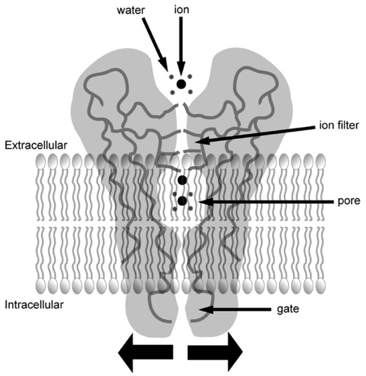
Our ability to sense heat, cold and touch is crucial to survival and underpins our interaction with the world around us. The 2021 Nobel Prize in Physiology or Medicine was also awarded to David Julius and Ardem Patapoutian for their Discoveries for temperature and touch. At present, most of the temperature and touch receptors we study are receptors on the cell membrane, which are non-selective oxygen ion channels that can receive physical and chemical signals.
Ion channel is a kind of transmembrane protein in biological cell membrane. Generally, several protein subunits enclose a pore filled with water. Different ion channels can open in response to different stimuli, allowing specific ions to pass through the hole, thus establishing and maintaining the potential difference and ion concentration difference between inside and outside the cell. Ion channels play a role in almost all physiological channels. For example, Piezo1, the calcium channel, senses the shear force of blood flowand Slo1, the potassium channel, is involved in sperm movement.
Due to the important role of ion channels, once they are too excited or too calm, they will cause a variety of diseases, such as neonatal diabetes caused by excessive activation of internal potassium channels, etc. The following are some abnormalities of ion channels formed with diseases:
| Disease types | Ion channels | Abnormal situation |
| Short QT syndrome | Voltage-gated potassium channel | Deactivation |
| Polycystic kidney disease | TRP cation channel | Excessive activation |
| Neonatal diabetes | Influx of potassium channel | Deactivation |
| Stiff baby syndrome | Glycine receptor channel | Deactivation |
| Epilepsy | Calcium channel | Excessive activation |
| Focal segmental glomerulosclerosis | Cyclic nucleotide gated channels | Excessive activation |
| Anemia | Piezo1 | Excessive activation |
As multiple transmembrane proteins, the extracellular region of ion channels is very small, so it is difficult to develop antibodies against ion channels, let alone antibodies with therapeutic functions. This should be the biggest challenge and the most promising direction for ion channel drug development.
Profacgen has invaluable value in the study of extremely large ion channel complexes such as GPCRs. We can provide personalized ion channel drug target screening and analysis services for you. Computer Aided Drug Design (CADD) service with advanced modeling and chemical informatics software as well as hardware such as clustered servers and 3D graphical displays. These resolved ion channel protein structures will become important targets for drug design, and once again demonstrate the power of Cryo-EM technology.

Please contact us for specific project implementation content and time. If you want to know more service information, please feel free to contact us, Profacgen will be your trusted partner.
Fill out this form and one of our experts will respond to you within one business day.